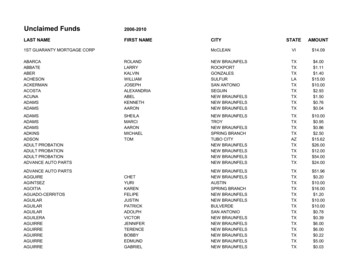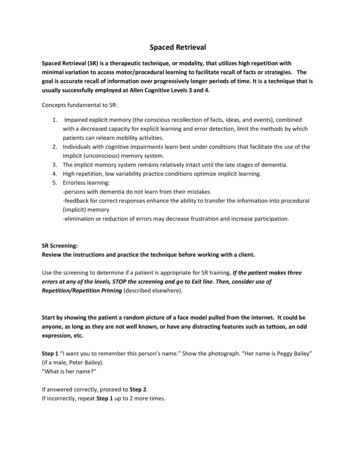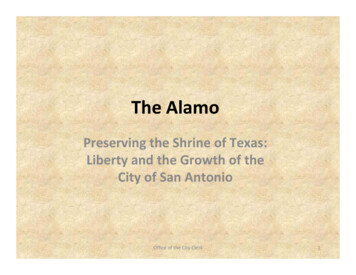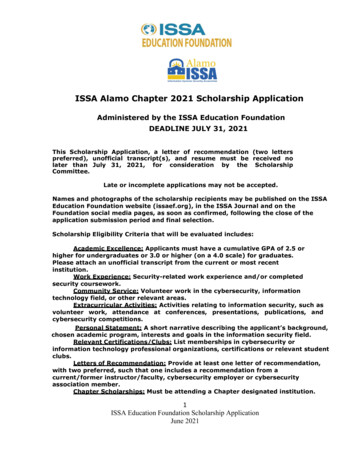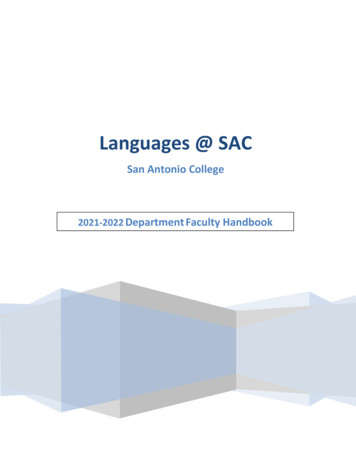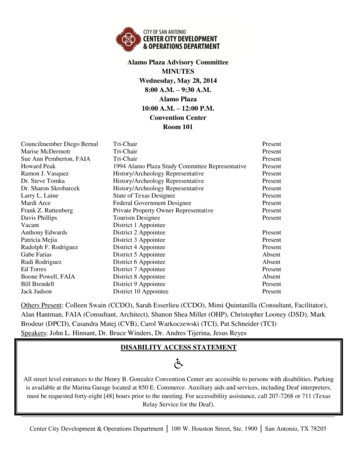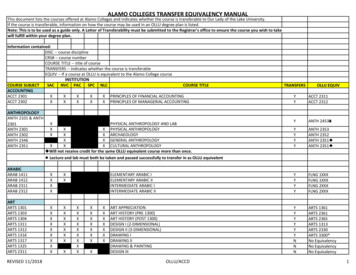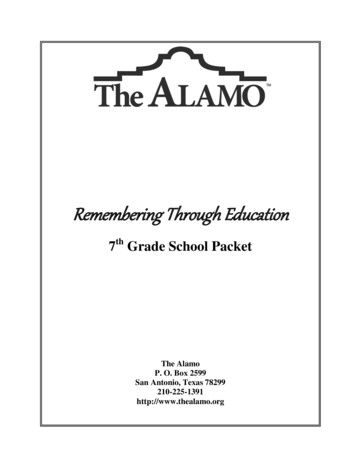
Transcription
Remembering Through Education7th Grade School PacketThe AlamoP. O. Box 2599San Antonio, Texas 78299210-225-1391http://www.thealamo.org
P. O. Box 2599San Antonio, Texas 78299(210) 225-1391Dear Educator:The Alamo strives to meet the needs of today’s classroom teachers. We realize that the schoolyear moves quickly, making planning critical. This Alamo Educator Packet is based on the TexasEssential Knowledge & Skills for Social Studies as specified by the Texas Education Agency. It isdesigned to create learning opportunities by providing ready-to-use reference material and activity sheetsthat can be used as either the basis of individual lessons or as sponge activities. We believe that thisinformation can easily be incorporated into the existing curriculum, enhancing learning in the area ofTexas History.The Battle of the Alamo was a epochal event not only in Texas History but in the history of theUnited States and Mexico as well. Several million visitors come to San Antonio each year to see thespot where a small band of Texans faced overwhelming odds for the cause of liberty. This event and themen and women who took part in it are too important to be forgotten. The story is a powerful learningtool and has sparked an interest in history for many young people and adults. The Alamo saga providesimportant lessons to a society looking for values.We welcome your suggestions as to how to improve our services to you. The Alamo is dedicatedto the task of helping educate Texans, young and old, about the wonderful history of this state. Visit uson the internet at http://www.thealamo.org.Sincerely,Richard Bruce Winders, PhDHistorian and CuratorThe Alamo
AN ALAMO TIMELINE 1718 - 1836Colonization Through Revolution1718Spanish officials established Mission San Antonio de Valero on San Pedro Creek.1719Officials relocated the mission to the east bank at the bend in the river.1724Officials relocated the mission a third and final time to its present location after a storm destroyedthe existing buildings. Construction at the new site began on a two-story convento, ormissionaries’ quarters.1727The two-story convento, acequia, and housing for the Indians were well under way. The mission’sIndian population totaled 273.1736The mission Indians built a bridge across the San Antonio River connecting their community tothe town of San Antonio de Béxar.1738-39A series of cholera and smallpox epidemics reduced the Indian population to 184.1744The two-story convento was finished. Workers laid the first stone of the church on May 8.1745Three hundred and fifty Apaches attacked San Antonio de Béxar but were driven off by 100mission Indians.1754The partially finished church completely collapsed due to poor construction.1756A second stone church, the present Alamo Shrine, was begun at Mission San Antonio de Valerobut never completed. At this time there were 328 Indians, the largest recorded number in thehistory of the mission.1758The keystone above the entrance to the church was inscribed with the date “1758.”1762Records show that the baptisms of Indian converts totaled 1,800 by 1762.1768Apache warriors defeated 500 Spanish soldiers, who were forced to retreat to the mission forsafety.1790The number of mission Indians had dwindled to 48.1793Spanish officials ordered Mission San Antonio de Valero secularized, or turned over to civilauthorities. The thirty-nine resident Indians who remained were given land and goods belongingto the former mission. The buildings were in a state of disrepair.1793-1802The former mission lay unoccupied except for squatters.1803A Spanish cavalry unit - La Compania Volante del Alamo de Parras - was stationed at the formermission. Gradually the former mission became known as Pueblo del Alamo, or more simply, theAlamo.1806-14The commander of the garrison established the first recorded hospital in Texas on the second storyof the convento.1812Officials moved religious records and activities to San Fernando Church across the river in SanAntonio de Béxar.
1813 (April)Governor Manuel María de Salcedo surrendered San Antonio to Republican forces led by JoséBernardo Gutíerrez de Lara and Samuel Kemper. The Republicans made the Alamo their quarters.1813 (August)The Alamo was reoccupied by Spanish General Joaquin de Arredondo following the defeat ofRepublican forces at the Battle of Medina.1814Cristóbal Dominguez was appointed ad interim governor. General Arredondo returned to Mexico.1820Moses Austin reported that the Alamo was in poor condition during his visit to San Antonio.1821Mexico gained its independence from Spain. Mexican officials ordered repairs on the buildings.1825La Compania Volante del Alamo de Parras was assigned to another post. The Alamo was againofficially left unoccupied.The Texas RevolutionOctober 1835General Martín Perfecto de Cos, acting under the orders of President Antonio López de SantaAnna, fortified the Alamo shortly after his arrival in San Antonio de Béxar at the head of a smallarmy.Dec. 10, 1835General Cos and about 1,200 troops surrendered the Alamo to a volunteer Texan Army of fewerthan 400 after a fierce battle for the city.Dec. 30, 1835After stripping the Alamo of supplies and men, Dr. James Grant and 200 men started on anexpedition to capture Matamoros.Jan. 6, 1836Colonel James C. Neill, commander of the Alamo, reported to the acting governor that he had104 men, but they lacked food or clothing.Jan. 7, 1836General Santa Anna and his army arrived at Saltillo, 365 miles from San Antonio de Béxar.Jan. 14, 1836Colonel Neill wrote to General Sam Houston, “Men in field four months. Today we were toreceive pay for the first month. I have 100 men. If they do not get paid, 20 of them will leaveimmediately for home.”Jan. 15, 1836Alamo garrison had decreased to 80 men as the volunteers continued to leave.Jan. 17, 1836Sam Houston ordered Colonel James Bowie to San Antonio de Béxar to evaluate the situation.Jan. 18, 1836Captain Green B. Jameson, a military engineer with the Texan Army, wrote General Houston tosay, “You can plainly see that the Alamo never was built by military people for a fortress.”Jan. 19, 1836Colonel James Bowie arrived in San Antonio de Béxar with 30 men.February 1836Tuesday 2Colonel Bowie and Colonel Neill held a conference in which they decided that the safetyof Texas depended on maintaining the Alamo as a fortress.Wednesday 3Colonel William B. Travis arrived in San Antonio de Béxar with 25 men. He agreed with Bowieand Neill that the Alamo must be defended.Monday 8David Crockett, former Congressman from Tennessee, arrived in San Antonio de Béxar with 16men.Wednesday 10Colonel Neill reported that the Alamo’s garrison, boosted by recent arrivals, totaled 142.
Thursday 11Colonel Neill left the Alamo on a leave of absence due to an illness in his family.Friday 12Colonel Travis assumed the role of Alamo commander.Saturday 13General Santa Anna’s army--headed for San Antonio de Béxar--was caught in a blizzard that leftmore than a foot of snow on the ground. In Goliad, Colonel James Fannin learned that GeneralUrrea had brought 1,000 Mexican troops to Matamoros, intended to help suppress the rebellion.This news caused the abandonment of the Matamoros expedition.Sunday 14Colonel Travis and Colonel Bowie agreed to share command of the 150 man garrison after adispute arose over control of the volunteers.Tuesday 16General Santa Anna crossed the Rio Grande and started for San Antonio de Béxar.Wednesday 17General Santa Anna arrived at the Nueces River, 119 miles from San Antonio de Béxar.Thursday 18A scout reported to Colonel Travis that the Mexican Army had crossed the Rio Grande.Sunday 21A cloudburst swelled the Medina River, thereby preventing Santa Anna from crossing. He wasonly eight miles away from San Antonio de Béxar.Monday 22General Santa Anna rested his troops while waiting for the Medina River to recede.13 DAYS OF THE SIEGE OF THE ALAMODay 1: Tuesday, February 23, 1836General Antonio López de Santa Anna arrived in San Antonio that afternoon with the vanguard of his army. Abloodred banner was raised atop the bell tower of San Fernando Church, signifying that no prisoners would betaken. Colonel William B. Travis ordered a cannon fired in response. The Mexican soldiers fired back and the siegeof the Alamo had begun. It was to last 13 days.Day 2: Wednesday, February 24, 1836Gravely ill, Colonel James Bowie turned over command of the volunteers to Colonel Travis. Travis sent CaptainAlbert Martin to Gonzales with a letter addressed "To the People of Texas and All Americans in the World."Day 3: Thursday, February 25, 1836A messenger reached Colonel James W. Fannin at Goliad. In San Antonio, Santa Anna moved his batteries closer tothe walls. A strong norther blew in that night around 9:00 P.M.Day 4: Friday, February 26, 1836A skirmish occurred east of the fort when a group of Texans, who had left the Alamo to gather wood, encounteredMexican troops. The Mexican Army tried to cut the Alamo’s water supply.Day 5: Saturday, February 27, 1836James Butler Bonham left the Alamo headed for Goliad and Gonzales. Back at the Alamo, nighttime activity by theMexican Army kept the Texans on alert, allowing them very little sleep.
Day 6: Sunday, February 28, 1836Colonel Fannin left Goliad at the head of a relief column but turned back after only traveling a short distance.Mexican artillery fire fell in and around the Alamo throughout the day.Day 7: Monday, February 29, 1836Santa Anna’s batteries moved still closer to the Alamo’s walls. The Mexican commander reviewed his troops. TheGonzales Ranging Company (32 men strong and commanded by Captain Albert Martin) left that town determined toreinforce the Alamo. [Note 1836 was a Leap Year.]Day 8: Tuesday, March 1, 1836The Gonzales Ranging Company arrived at the Alamo at 3:00 a.m., raising hopes that others would soon follow.Texans fired two cannon shots at the house on Main Plaza occupied by Santa Anna--one hit the house but he wasunharmed.Day 9: Wednesday, March 2, 1836Heavy Mexican cannonading continued. Inside the Alamo, the defenders were unaware that delegates meeting atWashington-on-the-Brazos had signed the Texas Declaration of Independence.Day 10: Thursday, March 3, 1836James Butler Bonham returned from Goliad to report that Colonel Fannin was not coming to the Alamo’s aid.Day 11: Friday, March 4, 1836Mexican cannonading started early and continued all day.Day 12: Saturday, March 5, 1836According to a popular legend, Colonel Travis drew a line on the ground with his sword and then asked thosewilling to stay and fight to cross over and join him. The Mexican bombardment ended at 10:00 p.m.Day 13: Sunday, March 6, 18361:00 a.m.2:00 a.m.3:00 a.m.4:00 a.m.5:00 a.m.6:30 a.m.The weary Texans slept while the Mexican troops moved into positions.Santa Anna and Colonel Juan N. Almonte discussed the battle plans.The Mexican troops were still moving into positions.The troops, now in position, laid on the ground in silence.Santa Anna gave the signal to advance just after 5 a.m. Four columns of Mexicantroops advanced on the Alamo. Casualties on both sides mounted during theintense fighting. The troops scaled the north wall and poured into the compound.The fighting moved to the Long Barrack, Low Barrack, and former church.THE ALAMO HAD FALLEN.
689To San Antonio (Béxar)5741115101216133142The AlamoMarch 6, 1836North11. Fortified Church2. Room of Dickinson &Esparza Families3. Fortified Stockpens4. Long Barrack5. North Wall6. Travis’ Quarters7. Gun Emplacement8. SW Corner-18 pounder9. Defensive Ditch10. Low Barrack & Bowie’sQuarters11. Kitchen12. Defensive Breastwork13. Abattis or Felled Trees14. Palisade Wall15. Hospital16. Powder MagazinesDaughters of the Republic of Texas, Inc.
The Alamo: Building A Scale ModelMaking a model of the Alamo is a popular project for students and individuals interested in the history ofthe site. Many maps and plats of the Alamo exist but discrepancies among them pose a problem for anyone whoundertakes the task of building a diorama or model of the Alamo. The Alamo compound has seen many uses duringits history and its structures have been altered repeatedly. Although it is impossible to determine the exactmeasurements of the buildings of the Alamo during the 1836 siege, the dimensions included in this packet are aclose approximation of the Alamo compound at the time of the siege and battle. The following sources wereconsulted in researching the Alamo’s dimensions:De Long, David G., ed. Historic American Buildings. Texas, Volume I. 2 vols. New York: Garland Publishing,Inc., 1979.Everett, Edward, “Plan of the Alamo, 1847.” Plan of the U.S Depot at the Alamo. Originals in the NationalArchives. Copies available at the DRT Library.Long, Charles J. “1836, The Alamo.” San Antonio: The Daughters of the Republic of Texas, 1981.Giraud, Francois, City Surveyor Drawings, City Engineers Office, Book 1. Made December 1849. Copies availableat the DRT Library.Hardin, Stephen L. Texian Iliad. Austin: University of Texas Press, 1994.Lord, Walter. A Time to Stand. Lincoln, NE: University of Nebraska Press, 1961.Nelson, George. The Alamo, An Illustrated History. Dry Frio Canyon, TX: Aldine Press, 1998.Nofi, Albert A. The Alamo and the Texas War for Independence. Conshohocken, PA: Combined Books, 1992.Potter, Reuben Marmaduke. The Fall of the Alamo: A Reminiscence of the Texas Revolution. San Antonio: Printedon the Herald Steam Press, 1860. The Fall of the Alamo. Hillsdale, NJ: Otterden Press; 1977 facsimile of 1878 edition.22’ 7 1/2”22’ 9 3/4”33’ 6”FRONT OF THE CHURCH IN 1836.Note: The parapet (arched cap) & two upper windows were added in 1850 by the U.S. Army.6’ 7.5”62’ 11 3/8”
NSThe Church25’ 3 7/8”Chancel12’ 6 ¼”12’ 6”The roof of the church wasstill uncompleted in 1836.The walls varied in thicknessfrom 43” to 48”.25’ 5”24’9 ¾”48’ 10 ¼”Transepts25’ 3”38’ 3”Nave20’ 5 ¾”23’ ½”20’ 6 ¾”105’ 8 ¼”15’ 6”32’ 7 ¼”Sacristy25’ 1”ConfessionalNorth: 11’ 9”South: 11’ 3 ¼”East: 11’ 5”West: 11’ 6”ConfessionalBaptistry25’ 2 ¾”62’ 11 3/8”The church and other permanent structures of the Alamo were built using a tan-colored limestone.BaptistryNorth: 10’ 11”South: 10’ 11 ¼”East: 10’ 8 3/8”West: 10’ 11 ¼”
243’ 9”105’ 8 ¼”ChurchPalisadeWall85’stock pen62’ 11 3/8”114 ‘74’stock penLong BarrackDimensions191’ 1 3/8” long19’ 11” wide503’ 3”537’ 5”200’The Alamo Compound, ca. 1836148’Long BarrackNWest Wall17’Low BarrackThe exterior walls of the compoundconsisted of a series of separate huts connected bywalls running between them. These huts and wallsvaried in height from 9’ to 12’.North Wall
12. & 13. Several cannon were located along the north wall of the compound.14. A low place in the north wall made it possible for the Mexican Army to enterthe compound.15. This low building formed a section of the east wall.16. Many Texans retreated to the Long Barrack after the soldiers entered thecompound. Some of the fiercest fighting occurred in and around this building.17. This area was used as a cattle pen.18. A cannon was positioned at the northeast corner of the cattle pen.19. This area, with its well, was used as a horse corral.20. A well in the plaza.21. A walled corridor connected the church to the Long Barrack.The Alamo in 18361. Construction was halted on the church in 1762 before the roof was completed.An earthen ramp made from the fallen roof arches led to an artillery platform onwhich several cannon were mounted.2. The front or west section of the church possibly had a flat roof.3. The front of the church lacked the distinctive profile it has today.4. A wooden palisade closed an open space between the church and the LowBarrack.5. A trench along the south wall provided additional protection.6. The Low Barrack formed a section of the south wall and contained severalsmall rooms as well as the main entrance to the Alamo.7. A lunette, or circular breastwork, protected the main entrance to the Alamo.8. An 18 pounder, the largest cannon in the fort, was located at this corner.9. A small cannon mounted on a low ramp was located here.10. Possible location of doors leading into the compound.11. A large pecan tree grew outside the northwest corner of the Alamo.
THE TEXIAN VOLUNTEERMany Texians did not have uniforms. They insteadwore hunting clothing that would hold up in outdoorconditions. The frock (another word for coat) was made ofeither buckskin or linen. The cape on the frock wasdesigned for extra warmth. The fringe at the bottom of thecape and along the sleeves was not just a decoration – ithelped the garment dry faster. A linen shirt, buckskin orlinen pants, and moccasins completed the outfit. A fur capsometimes replaced the broad brimmed felt hat in coldweather.This Texian is armed with a single-shot flintlockrifle. Although it had a range of twice as far as the standardmilitary musket, the rifle took much longer to load and fire.Unlike the musket, the rifle did not have a bayonet.Frontiersmen carried long knives to make up for thisdrawback. A hollowed out horn from a cow or a buffalo,slung over the shoulder, carried gunpowder. A leatherpouch was also carried over the shoulder and containedlead bullets, patches, and spare flints.The Texian Army at the beginning of the revolutionwas made up mainly of colonists who had already settled inTexas. Gradually, however, volunteers from the UnitedStates arrived who wanted to help win Texas’independence. Many Tejanos (Texas-born Mexicans) alsofought against the government of General Antonio Lópezde Santa Anna.Things To Think About1. Define the word “Texian.”2. Compare and contrast the advantages and disadvantages of the rifle and musket.3. What was the relationship between Texian colonists and their environment?4. Why were people in the United States interested in events in Texas?5. Why did the Texians want their independence from Mexico?
TEJANO VOLUNTEER1. List three items that indicate that thisTejano volunteer lives on the TexasFrontier.a.b.c.2. This Tejano wears a crucifix on his hatand a medallion with the image of theVirgin de Guadalupe around his neck.What do these items signify?3. A gourd hangs by his side. What does ithold?4. Why did some Tejanos support the fight against the Mexican Government?5. Identify three Tejanos who supported independence and describe their individualcontributions.a.b.c.
TEJANAThe term Tejana refersto a woman of Mexicanheritage born in Texas. Therewere several Tejanas insidethe walls during the Battle ofthe Alamo.This woman is wearinga dress and a shawl or rebozo.The rebozo could be used forwarmth in cold weather orused to cover the head. She iswearing a religious medalaround her neck, perhaps withthe image of the Virgin ofGuadalupe.A woman in the 1830’swas responsible for thekeeping of the house andrearing of the children. SomeTejanas were landowners.Often they would inherit landfrom their husbands or fathers.Many became the head oflarge cattle ranches.1. Why is this Tejana wearing a medallion with the image of the Virgin of Guadalupe?2. Where would a Tejana woman in the 1830s get her clothing?
THE MEXICAN SOLDIER(El Soldado Mexicano)Mexican soldiers wore dark-blue uniformcoats trimmed in various colors to represent theirdifferent regiments. White cotton pants were wornin the summer and light-blue wool pants worn in thewinter. Their tall hats, called shakos, were made ofleather. Although supposedly issued shoes, manyMexican soldiers wore sandals.Personal possessions and extra equipmentwere stored in a knapsack that the soldier carried onhis back. Leather belts, worn over the shoulder, heldtwo important pieces of equipment – the cartridgebox and the bayonet scabbard. A smaller strap helda canteen or gourd for carrying water.The single-shot flintlock musket was used bythe infantry. A well-trained soldier could load andfire his musket three times a minute. An eighteeninch-long bayonet attached to the end of the barrel atthe muzzle of the musket. A strap or sling allowedthe soldier to carry the weapon over his shoulder.Being a soldier was hard work. He wasexpected to be able to march at least ten miles a daywhile carrying his own food, knapsack, ammunition,and musket. The combined weight of these itemsoften added up to thirty to forty pounds.Things To Think About1. What did soldiers eat? How did they cook their food?2. Who took care of soldiers when they were ill?3. Where did soldiers sleep?4. Describe a typical day in the life of a soldier in the Mexican Army.5. How is a soldier’s life different from your life?
TEXAS AND THE REVOLUTIONLabel the following rivers:Brazos RiverGuadalupe RiverRio GrandeSabine RiverSan Antonio RiverSan Jacinto RiverNumber the dots that represent the following atamoros6.7.8.9.10.San Antonio de BéxarSan JacintoSan Felipe de AustinWashington-on-the-BrazosVelasco
Selected Alamo BiographiesWilliam Barret TravisWilliam Barret Travis, commander of the Alamo, was born on August 9, 1809 inSaluda County, South Carolina. Travis’ father moved the family to Conecuh County,Alabama in 1817. Travis was enrolled in a school in Claiborne, Alabama. There heassisted other students in their studies. Travis became an apprentice of the leadingattorney in Claiborne and eventually his partner.On October 26, 1828, Travis married Rosanna Cato. Their first child, CharlesEdward Travis, was born on August 8, 1829. Travis became involved in the Claibornecommunity by joining the Masonic Lodge, starting a newspaper and accepting a positionin the Alabama Militia. Despite these personal successes, the Travis’ marriage wasfalling apart. Both accused the other of infidelity and Travis would leave his wife, sonand unborn daughter.Travis, like so many others, chose Texas to start a new life. He arrived in 1831and established a law practice in Anahuac on Galveston Bay.In the course of practicing law in Texas, Travis met men associated with the warparty, a group of militants opposing the Law of April 6, 1830.In 1832, Travis was retained to help secure the return of runaway slaves beingheld by the commander of the Mexican garrison at Anahuac. Eventually, Travis and hislaw partner were jailed in two brick ovens. As men began to gather in protest, theMexican Commander realized that he was outnumbered and released the two men.Travis moved his law practice to San Felipe and was elected to the town council.He also met Rebecca Cummings and they became engaged in 1834. Meanwhile, Travis’wife, Rosana traveled to Texas in the fall of 1835, in order to get her husbands signatureon divorce papers. She left their son, Charles, with him. Travis arranged for Charles tostay with David Ayers and family as he was caught up in the Texas Revolution.Travis participated in the Grass Fight near Béxar. He accepted a commission oflieutenant colonel of cavalry. He was ordered to recruit 100 men and reinforce theAlamo. Although he could only recruit 29 men, he arrived in San Antonio in January1836. He shared command of the Alamo with James Bowie until Bowie fell ill onFebruary 24th. After General Santa Anna’s arrival in San Antonio on February 23rdTravis penned letters to the provisional government of Texas explaining their situationand requesting reinforcements. The most famous of these letters was written on February24, 1836 and began, “To the people of Texas and all Americans in the world ” Traviswas killed early on the morning of March 6 as the Mexican army attacked the compound.According to his slave, Joe, Travis was shot through the head early in the battle as hedirected fire on the north wall. His body was burned with those of the other defenders.
David CrockettFrontiersman, congressman and Alamo defender, David Crockett was born inGreene County, East Tennessee, on August 17, 1786. He rose from humble beginningsto become a United States Congressman from his home state of Tennessee. At the age oftwelve, David’s father hired him out to Jacob Siler to help drive a herd of cattle toVirginia. David came home a few weeks later and received what would become a veryshort formal education.He married Mary (Polly) Finley in 1806 and started a family. In 1813, DavidCrockett enlisted as a scout to avenge the Indian attack at Fort Mims, Alabama. Heparticipated in the massacre of Tallussahatchee. He would reenlist several more times inthe militia each time rising in rank.Upon his return home in 1815 he found himself to be a father again, and beforethe year’s end would also be a widower. Crockett married Elizabeth Patton, a widowwith 2 children.In 1817, Crockett became a justice of the peace, a position he would hold until1819. It was also during this time that he decided to run for the Tennessee legislature andwas elected first in 1821 and then again in 1823. He then decided to run for the UnitedStates Congress and was elected in 1827. He would be reelected to Congress two moretimes.During his years in Congress, many books and plays were being written based onhis exploits as a frontiersman. Crockett was on his way to possibly becoming president.In 1835 he lost his congressional seat and decided to leave Tennessee behind to exploreTexas. On his way to Texas, he stopped at the Union Hotel and made his famous remark,”Since you have chosen to elect a man with a timber toe to succeed me, you may all go tohell and I will go to Texas.”David Crockett arrived in Texas on January 9, 1836, with the prospects of movinghis family there, but upon arriving found himself in the middle of a revolution. He joinedthe Texas Army and was sent to San Antonio de Béxar and to the Alamo. David Crockettdied on the morning of March 6, 1836 fighting alongside the rest of the Alamo defenders.James Butler BonhamJames Butler Bonham was born on February 20, 1807 in Saluda County, SouthCarolina. He attended college, but did not graduate. He studied law and began practicingin Pendleton, South Carolina, in 1830. On October 17, 1835, Bonham led a rally tosupport the Texan cause in Mobile, Alabama. Two weeks later, he helped organize thevolunteer company of Mobile Grays. He was in Texas by November of 1835.Bonham was commissioned a second lieutenant in the Texas cavalry and declinedall payment for his service. On February 1, 1836, he was unsuccessful in becoming aBéxar garrison delegate to the Constitutional Convention. He was sent to get help for theAlamo on February 16, 1836 and returned on March 3, 1836. Bonham would be the last
man to arrive at the Alamo before the battle. He died with the other defenders on March6, 1836.José María (Gregorio) EsparzaAlamo defender José María Esparza better known as Gregorio was born onFebruary 25, 1802 in San Antonio de Béxar. He married Anna Salazar and together theyhad four children. In October 1835, Esparza enlisted in Juan Seguín’s company. Heparticipated in the siege and Battle of Béxar against the Mexican Army. He served untilDecember 10, 1835.When news came of Antonio López de Santa Anna’s arrival in San Antonio, theEsparza’s were advised to take refuge in the Alamo since they supported the revolt. Theyentered the Alamo through a window and Gregorio chose to remain and fight eventhough Tejanos were being allowed to leave. His family remained with him. He manneda cannon and died at his post on March 6, 1836. His family survived the battle. After thefall of the Alamo, Francisco, a Mexican soldier and brother of Gregorio asked SantaAnna for his brother’s body for burial. He was the only Alamo Defender to be given aChristian burial in the Campo Santo of San Antonio de Béxar. His son Enrique, anAlamo survivor, would tell the story of what occurred during the battle.José Toribio LosoyaTejano Alamo defender José Toribio Losoya was born on April 11, 1808. Thefamily home was located in the southwest corner of the Alamo compound. ToribioLosoya was married to Concepción Cubier and was the father of three. In 1830, Losoyawas serving in the Alamo de Parras Company under Lt. Colonel Francisco Ruiz. It wasin the same year that the Alamo de Parras company was sent to build and occupy FortTenoxtitlan on the Brazos River. He returned to San Antonio in 1832. When thegovernment announced the abolishment of the federal constitution, Losoya was one ofmany soldiers that opposed Santa Anna. By 1835 he had deserted the Mexican Army andwas serving with Juan Seguín’s company. He took part in the siege and battle of Béxarand would later help reinforce the Alamo. Losoya would fall at the Battle of the Alamoalong with the other defenders on March 6, 1836.Juan Nepomuceno AlmonteMexican officer and diplomat, Juan Nepomuceno Almonte was born inMichoacan on May 15, 1803. Almonte was sent to the United States to be educated.When he returned to Mexico he joined the fight against Spain. In 1822, he was sent toTexas to serve under the newly appointed governor José Félix Trespalacios. In 1824, hewas sent to London as part of the legation, where he negotiated Mexico’s firstcommercial treaty. In 1830 he served in the National Congress, but came underpersecution by the government and had to hide due to his editorial works againstPresident Anastasio Bustamante. In 1834, Almonte made an inspection of Texas andwrote a detailed report of his findings. He served in the Texas campaign under SantaAnna as his secretary and confidential adviser. Almonte also participated in the assault on
the Alamo. He was captured following the Mexican Army’s defeat at the Battle of SanJacinto.In 1837 he was sent to the U.S. with Santa Anna. In 1841, he was sent toWashington where he served as minister until 1845 when Texas was annexed. He servedas secretary of war during the Mexican American War. After the war he was sent toLondon as a minister but neglected his duties to promote a foreign intervention in Mexicowith the French. In 1862 he arrived in Veracruz to help establish the monarchy, finallyfulfilling the 1821 Plan de Iguala. He was declared supreme chief of the Nation by theFrench. He was a
Jan. 19, 1836 Colonel James Bowie arrived in San Antonio de Béxar with 30 men. February 1836 Tuesday 2 Colonel Bowie and Colonel Neill held a conference in which they decided that the safety of Texas depended on maintaining the Alamo as a fortress. Wednesday 3 Colonel William B. Travis arrived in San Antonio de Béxar with 25 men.


